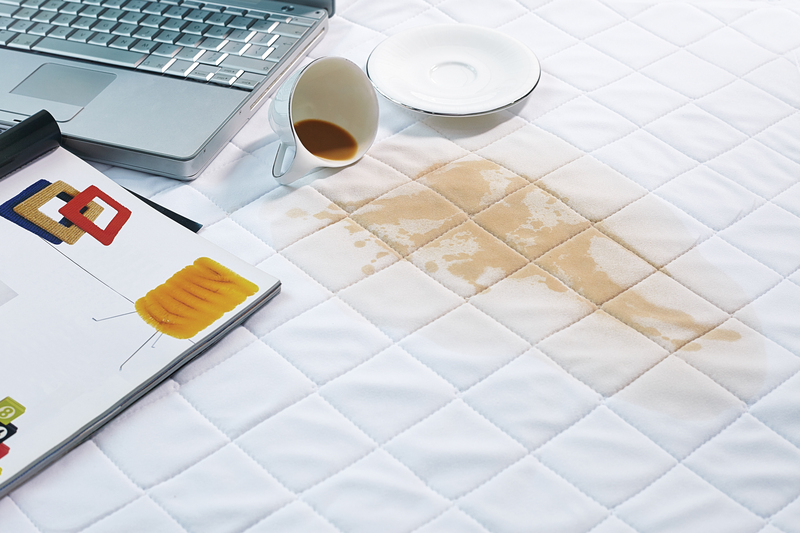Your Complete Manual for Tidy Curtains
Posted on 17/06/2025
Your Complete Manual for Tidy Curtains
Are your curtains looking a little less crisp these days? Are you searching for the ultimate guide on how to keep window treatments pristine, fresh, and visually appealing? You're not alone! Curtains and drapes are focal points in any room, but they also tend to collect dust, pet hair, stains, and odors over time. If you're confused about the best cleaning practices, maintenance tips, and storage methods, you've just found your complete manual for tidy curtains.

Why Curtain Cleanliness Matters
Maintaining clean curtains isn't just about aesthetics; it also impacts your home's air quality and can extend the life of your curtains. Here's why routinely tidying your curtain panels is essential:
- Dust and Allergen Control: Dust, pollen, and other allergens accumulate quickly on fabric surfaces, causing sneezing and allergic reactions.
- Improved Ambiance: Fresh, clean curtains brighten up your living space and contribute to a welcoming, well-kept atmosphere.
- Longevity: Regular maintenance prevents wear and tear, color fading, and fabric deterioration, ensuring you get the most out of your investment.
Identifying Your Curtain Fabric
The first step in curtain cleaning is understanding what kind of material you're working with. Here are the most common curtain fabrics and their care requirements:
- Cotton Curtains: Durable, usually machine washable. May shrink if not washed according to guidelines.
- Linen Curtains: Natural fiber, often prone to wrinkles and shrinkage. May require gentle washing or dry-cleaning.
- Silk Curtains: Delicate, should typically be dry-cleaned to prevent discoloration and damage.
- Polyester Curtains: Easy to clean, usually machine-washable and wrinkle-resistant.
- Velvet Curtains: Dense, luxurious fabric. Requires gentle handling and often dry-cleaning.
- Blends and Synthetics: Often more durable and less fussy, but always check the manufacturer's care label.
Always consult the care label attached to your curtain panels before starting any cleaning process. If in doubt, test a small, inconspicuous area first.
Routine Maintenance for Pristine Curtains
Consistent, light upkeep helps keep your beautiful curtains looking their best between deeper cleans:
Weekly Dusting
- Use a vacuum cleaner: Attach the upholstery brush to gently remove dust and debris from the fabric's surface every 1-2 weeks.
- Shake them out: Take down lightweight curtains and give them a good shake outside to dislodge dust and pet hair.
- Lint roller: Great for spot cleaning, especially for households with pets.
Spot Cleaning Stains
- Address stains promptly: Dab (don't rub) spills and stains with cold water and mild detergent.
- Avoid harsh chemicals: Unless specified on the care tag, stick to gentle products to prevent dye run.
- Blot instead of scrub: Blotting prevents the stain from spreading deeper into the fibers.
Deep Cleaning Curtains: Step-by-Step Guide
Perform a deep clean every 3-6 months or as needed. Your method will depend on fabric type:
How to Machine Wash Curtains
- Remove hardware: Take down the curtains and remove all pins, hooks, and rings.
- Check the care label: Confirm the fabric is machine-washable.
- Gentle cycle: Wash with cold or lukewarm water on a gentle cycle using mild detergent.
- Do not overload: Curtains need plenty of space to move in the wash.
- Dry correctly: Air dry on a rod or tumble dry on low, removing when slightly damp to minimize wrinkles.
Hand Washing Curtains
- Fill tub with cool water and detergent: Submerge panels, swish gently by hand.
- Rinse thoroughly: Ensure all soap residue is gone to prevent stiffness.
- Press (don't wring): Gently squeeze out excess water.
- Air dry: Lay flat or hang immediately to avoid creasing.
Dry Cleaning Curtains
- Consult the label: Dry-clean-only fabrics like silk and velvet mustn't be washed at home.
- Professional service: Take to a trusted cleaner, especially for lined or intricately detailed drapes.
The Secret to Odor-Free Curtains
Curious how to keep your curtains smelling fresh? Use these tips:
- Airing out: Occasionally open windows so curtains get fresh air.
- Baking soda: Sprinkle lightly on the fabric, let sit, and vacuum away for odor absorption.
- Essential oil sprays: Lightly mist with diluted essential oils like lavender or lemon for a pleasant fragrance (test fabric first!).
How to Iron and De-Wrinkle Curtains
Nothing says "tidy window treatments" like smooth, crease-free panels. Here's how to minimize wrinkles:
- Iron while damp: Ironing slightly moist curtains with a warm iron is most effective for cotton, polyester, and blends.
- Use a steamer: Handheld garment steamers can remove wrinkles while the curtains hang. Always check heat tolerance first.
- Hang with care: Gravity will help pull out minor wrinkles as curtains hang.
Professional Curtain Cleaning: When and Why?
Some situations call for expertise:
- Large, heavy drapes: Oversized draperies are difficult to manage at home.
- Delicate materials: Silk, velvet, and other sensitive fabrics are best left to the professionals.
- Persistent stains or odors: Expert cleaning can tackle what home methods can't.
How to Keep Curtains Tidy between Washes
- Open and close with care: Use the curtain's intended mechanisms or tiebacks to reduce fabric stress.
- Reduce sun exposure: Direct sunlight fades fabrics. Use a sheer layer or blinds behind your main curtains for protection.
- Keep windows clean: Dirt from panes and frames can transfer to your fabrics.
- Avoid moisture: Bathrooms and kitchens create sticky, damp environments. Select moisture-resistant or easy-to-clean panels for these spaces.
Special Curtain Types and Their Care
Blackout Curtains
- Vacuum frequently: Their dense fabric traps more dust.
- Sponge clean for stains: Avoid immersing unless care label allows.
Sheer and Lace Curtains
- Hand wash or delicate cycle: Use gentle detergent with lukewarm water, and handle with care.
- Lay flat to dry: Prevents stretching and misshaping.
How to Store Curtains Properly
Proper storage is crucial for curtain longevity--especially for seasonal or spare sets.
- Wash before storing: Never pack away dirty curtains; stains set with time.
- Fold loosely: Avoid harsh creases by rolling or gently folding panels.
- Use breathable bags: Fabric bags or pillowcases protect against dust but allow moisture escape.
- Store in a dry, cool place: Humidity can cause mildew and fabric weakening.
Common Curtain Cleaning Concerns & Mistakes (and How to Avoid Them)
- Skipping the care tag: Always check for cleaning recommendations BEFORE you start.
- Using too much detergent: Excess soap can leave residue and attract more dirt.
- Washing at high temperatures: Hot water can shrink and fade fabric--stick to cool settings unless otherwise stated.
- Putting wet curtains back up: This can cause stretching, mildew, or permanent wrinkles. Wait until they're slightly damp or fully dry, as per fabric.
Quick Reference: Curtain Care Tips
- Check your fabric: Each type has different rules--respect them!
- Dust and vacuum: It's the #1 way to keep them fresh between washes.
- Don't overload the washer: Give your curtains room to move.
- Test before spot cleaning: Avoid spreading the stain or damaging the color.
- Consider professional help: For specialty fabrics or stubborn issues.

FAQs About Curtain Cleaning and Maintenance
Q: How often should I clean my curtains?
A: As a general rule, routine curtain dusting should be done every 1-2 weeks, with deep cleaning every 3-6 months, or more often if you're in a high-traffic or high-allergen area.
Q: Can I put all curtains in the washing machine?
A: No. Always check the care label. Machine washing is suitable for cotton, polyester, and some blends, but delicate or lined curtains may require hand washing or dry-cleaning.
Q: How do I dry curtains after washing?
A: Ideally, hang them while still damp for the best shape and least wrinkles. Tumble dryers should be used with care and only for compatible fabrics.
Q: What's the best way to keep curtains looking good long-term?
- Regular dusting
- Gentle handling during opening and closing
- Avoiding excess sun and humidity
- Prompt attention to stains and odors
Conclusion: Enjoying Beautiful, Tidy Curtains Year-Round
Your home deserves spotless, stylish curtain panels that enhance both your living room's appearance and its indoor air quality. By following the steps outlined in your complete manual for tidy curtains--from identifying fabric and routine care to handling deep cleans and proper storage--you'll protect your drapes and keep your windows looking magazine-worthy.
Remember: Prevention and consistency are your best friends when it comes to curtain maintenance. Whether you're a home decor enthusiast or just aiming for a fresher, more inviting space, treating your curtains well will pay off in comfort and aesthetics for years to come.
Maintain your tidy curtains, and enjoy a healthier, more beautiful home environment--one window at a time!



